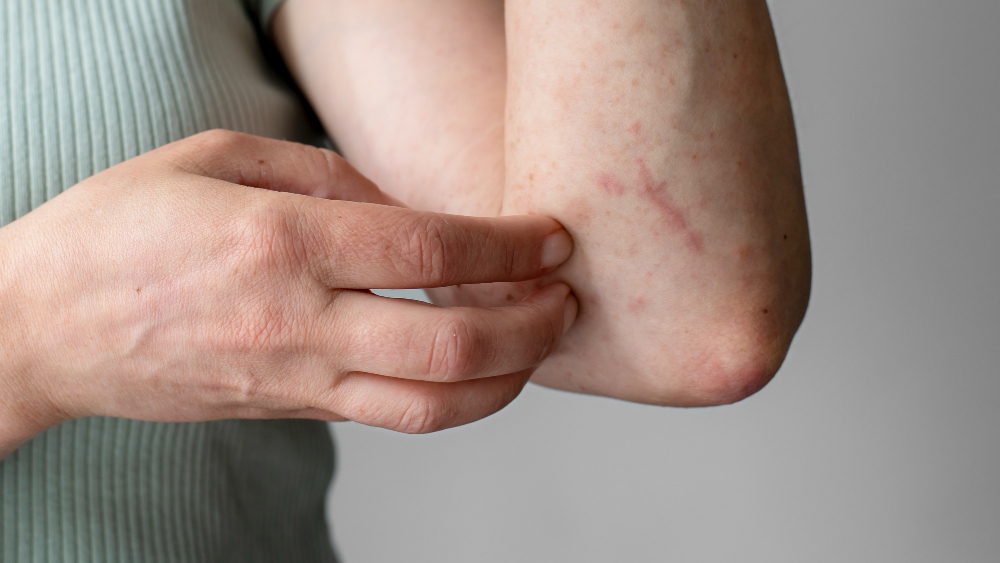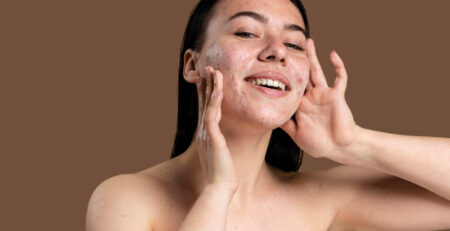Keratosis Pilaris (Chicken Skin)
Keratosis pilaris, also called “chicken skin,” is a common skin condition that makes rough-feeling bumps appear in patches. These tiny bumps or pimples are actually hair follicles that are blocked by dead skin cells. They can sometimes look red or brown.
Keratosis pilaris is usually found on the upper arms, thighs, cheeks, or buttocks. It’s not contagious, and the bumps don’t hurt or itch most of the time.
This condition is known to get worse in the winter, when the skin tends to dry out, and may also get worse during pregnancy.
This harmless, genetic skin condition can’t be cured, but it can be treated or kept from getting worse. Most people with Keratosis Pilaris get rid of it on their own by the time they are 30 years old.
What are the symptoms of keratosis pilaris?
The most obvious sign of keratosis pilaris is how it looks. The bumps on the skin look like goosebumps or the skin of a chicken that has been plucked. Because of this, it is often called “chicken skin.”
The bumps can show up anywhere on the skin where hair follicles are. They won’t show up on the soles of your feet or palms of your hands, though, because there are no hair follicles there. Most people with Keratosis Pilaris have it on their upper arms and thighs. It can spread to the forearms and lower legs if it gets too bad.
It also has the following other symptoms:
- a little pink or red around bumps;
- skin that itches and irritates you
- Dry bumps on the skin that feel like sandpaper and can be different colours depending on the colour of the skin (flesh-colored, white, red, pink, brown, or black)
Keratosis pilaris causes
keratin, a protein found in hair, builds up in the pores and causes this harmless skin condition.
When you have keratosis pilaris, the keratin in your body hair gets stuck in your pores, which stops hair follicles from growing. Because of this, there is a small bump where a hair should be. If you picked at the bump, a small body hair might come out.
Doctors don’t know for sure what causes keratin buildup, but they think it may be linked to skin conditions like atopic dermatitis and genetic diseases.
Who can develop keratosis pilaris?
Chicken skin is common in women, kids and teens, people with Celtic roots, and people with:
- dry skin
- eczema
- ichthyosis
- hay fever
- obesity
This skin condition can happen to anyone, but kids and teens are most likely to get it. Keratosis pilaris usually starts in late childhood or when a person is a teenager. It usually goes away by the time a person is in their mid-20s, and most cases are gone by the time they are 30.
During pregnancy and puberty, hormonal changes can cause flare-ups. Most people with fair skin get Keratosis Pilaris.
How keratosis pilaris is diagnosed
Keratosis pilaris is found by looking at a person’s medical history and giving them a physical exam. A dermatologist, who is a doctor who specialises in skin, can usually tell what’s wrong by looking at the affected area. Some of the things that go into the diagnosis are:
- your age
- what it looks like
- which areas it affects
There are no official tests that can confirm the diagnosis.
How to get rid of keratosis pilaris
No one knows how to get rid of keratosis pilaris. Most of the time, it gets better on its own. You can try some treatments to improve the way it looks, but keratosis pilaris is usually hard to treat. If the condition gets better at all, it could take months.
Dermatological treatments
Your dermatologist may suggest a moisturising treatment to relieve your skin’s itching and dryness and make the keratosis rash look better. There are many over-the-counter and prescription creams that can get rid of dead skin cells or keep hair follicles from getting clogged. The best treatment for you can be decided by a doctor or other health care professional.
If you don’t already have a dermatologist, our Healthline FindCare tool can help you find doctors in your area.
Urea and lactic acid are two ingredients that are often found in moisturisers. Together, these ingredients help loosen and get rid of dead skin cells, as well as soften and moisturise dry skin. A dermatologist may also suggest the following treatments:
- microdermabrasion, an intense exfoliating treatment
- chemical peels
- retinol creams
But be careful about what’s in these creams and talk to a doctor before you use them. Some prescription creams on the skin contain acids that can cause side effects like:
- redness
- stinging
- irritation
- dryness
There are also some treatments that are still being tested, such as photopneumatic therapy and vascular laser treatment.
Can keratosis pilaris be prevented?
Keratosis pilaris isn’t something you can avoid. But taking care of your skin gently can help stop flare-ups and make it look less bad. For example, moisturize your skin with a cream or ointment without oil can help keep your pores from getting clogged, which can lead to keratosis pilaris.
Keratosis pilaris home remedies
If you don’t like the way your keratosis pilaris looks, you can try some at-home treatments. Even though there is no cure for the condition, self-care can help reduce bumps, itching, and irritation.
- Take warm baths: Taking short, warm baths can help unclog and loosen pores and make them less tight. But it’s important to limit the amount of time you spend in the bath because long wash times can strip the body of its natural oils.
- Exfoliate: Daily exfoliation can help improve the appearance of the skin. Dermatologists recommend gently removing dead skin with a loofah or pumice stone, which you can purchase online.
- Apply a lotion that will keep your skin hydrated. Lotions with alpha hydroxy acids, like lactic acids, can keep dry skin hydrated and speed up cell turnover. Some dermatologists recommend online-available products like Eucerin Advanced Repair and AmLactin. Most beauty supply stores sell glycerin, which can also be used to soften bumps. Rose water can be used to calm irritated skin.
- Don’t wear clothes that are too tight. Clothes that are too tight can cause friction, which can irritate the skin.
- Use a humidifier. Humidifiers add moisture to the air in a room, which helps your skin keep its moisture and stops itchy flare-ups.
The takeaway
Keratosis pilaris is a skin condition that is often called “chicken skin” because of the way it looks. It usually affects young people. Even though there is no cure, it usually goes away on its own by the time you are 30.
Until then, you can take some steps to deal with it. Consult a dermatologist to find out how to treat it best.










Leave a Reply